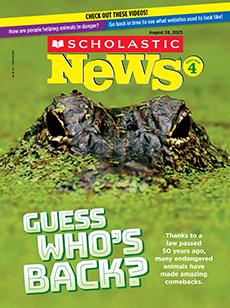Like most fourth-graders, Kenuel Latham learns math, science, and reading in school. But his music class is probably not what you’d expect. Kenuel and his classmates sing in a language most Americans don’t understand. They also wave fans made of feathers and wear beaded headdresses.
“Sometimes we make drums or learn new dances,” says Kenuel. “It’s really fun.”
But this class isn’t just for fun. It’s part of an effort to save a dying language. Students at Kenuel’s school in Bethel, Alaska, are taught in Yup’ik. That’s the language that was spoken by their ancestors.
Yup’ik is one of 20 Native Alaskan languages in danger of disappearing within the next 100 years. The students at Kenuel’s school are working to keep that from happening.
“The best way to save a language is to teach the young people,” says Roy Mitchell. He’s an expert on Alaska’s languages.
Like most fourth-graders, Kenuel Latham learns math, science, and reading in school. But his music class is probably not what you’d expect. Kenuel and his classmates sing in a language most Americans don’t understand. They also wave fans made of feathers. They wear beaded headdresses.
“Sometimes we make drums or learn new dances,” says Kenuel. “It’s really fun.”
But this class isn’t just for fun. It’s part of an effort to save a dying language. Kenuel goes to school in Bethel, Alaska. Students there are taught in Yup’ik. That’s the language that was spoken by their ancestors.
There are 20 Native Alaskan languages in danger of disappearing. Yup’ik is one of them. That could happen within the next 100 years. The students at Kenuel’s school want to stop that from happening.
“The best way to save a language is to teach the young people,” says Roy Mitchell. He’s an expert on Alaska’s languages.
